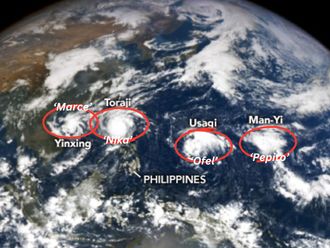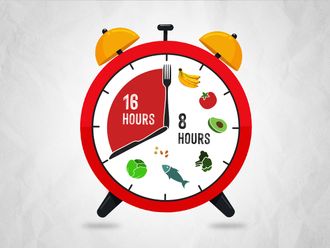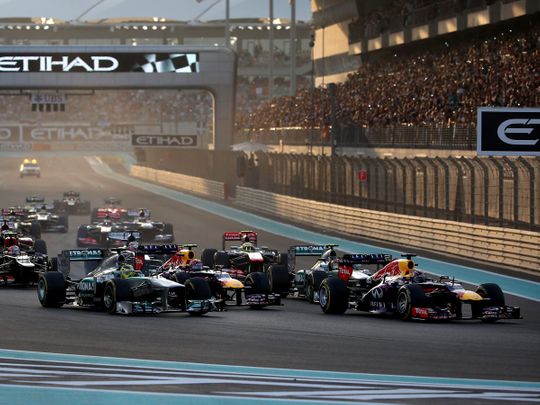
Lewis Hamilton or Max Verstappen: who will be the new Formula One champion? The 13th Abu Dhabi Grand Prix will have the answer when the chequered flag goes up on December 12. All eyes of motorsport enthusiasts will be on the new-look course of the Yas Marina Circuit where the most important race of the year gets underway.
Here’s a look at season, a bit of history and the evolution of the sport, the technology and a guide to the world of Formula One racing.
Yas Marina Circuit gears up ready for F1 thriller
Matthew Smith, Sports Editor
Abu Dhabi is putting together the final touches on a stage that is about to witness one of the most dramatic climaxes to a Formula One season.
After a record 21 races in an epic season, Mercedes’ Lewis Hamilton and Red Bull’s Max Verstappen cannot be separated by a single point going into the UAE finale, with both drivers locked on 369.5 points apiece — a country mile ahead of Valtteri Bottas (218) in third.
In recent years, Hamilton’s dominance has seen the title race wrapped up well before the last race of the season, but Verstappen and Red Bull’s fine performances mean we are going down to the wire for the first time since 2016 when Nico Rosberg pipped Mercedes teammate Hamilton before the German’s abrupt retirement following his one and only Drivers’ title.
Since then it has all been about Hamilton, who now has seven crowns — tied with the great Michael Schumacher at the top of the pile and well in the know that one more epic drive will make him the greatest driver of all time.
But now for the curveball. While Hamilton has tussled with the greats of the game for the past 15 or so years, including Fernando Alonso, Rosberg and Sebastian Vettel, Verstappen made his breakthrough as a fresh-faced 17-year-old in 2015 for Torro Rosso before getting the push up to Red Bull, and he just keeps getting better and better, and has arguably been the greater driver than Hamilton this season.
While the Dutchman has a slight advantage on race-win countback this season (9-8), Abu Dhabi has been a happy hunting ground for Hamilton, with five race wins here. But if anyone can stop him it is Verstappen, who takes no prisoners on track and has already been involved in many wheel-to-wheel incidents with his British rival this season.
It could all come down to the new-look Abu Dhabi track this weekend, with three improved corners to allow for more overtaking — something that could play into the more daring Verstappen’s hands.
Regardless of what unfolds on Sunday, the 2021 season and the Abu Dhabi showdown will go down in history as one of the most gripping events in motorsport history.
F1 history: From road races to gleaming circuits
Shyam A. Krishna, Senior Associate Editor
The roar of engines and screeching of brakes fill the racing circuit as cars zip around at incredible speeds. That’s Formula One racing. That’s the world of motorsport. How did it all start?
The origins of Formula One racing can be traced to the races on public roads in Europe at the end of the 19th century. The appellation “Grand Prix” was first used for 1901’s French Grand Prix at Le Mans. The European Grand Prix racing of the 1920s and 30s were precursors to Formula One races.
There are several claimants to the first Formula One race. The 1947 Pau Grand Prix, won by Nello Pagani on Maserati 4CL, could be the first F1 race. It conformed to the standardised set of rules, referred to as Formula One, drawn up in 1946 by the Commission Sportive Internationale (CSI), the predecessor of Fédération Internationale de l’Automobile’s (FIA). It defines Formula One as a premier single-seater racing category in motorsport.
The formula based on engine capacity to level the playing field became effective in 1947. It was initially known as Formula A, Formula I, or Formula 1. But the races from 1946-1950 were not part of an organised calendar. The first race labelled “International Formula One” took place at the same venue three years later. Argentine Juan Manuel Fangio, who became an F1 legend, won the race in a Maserati.
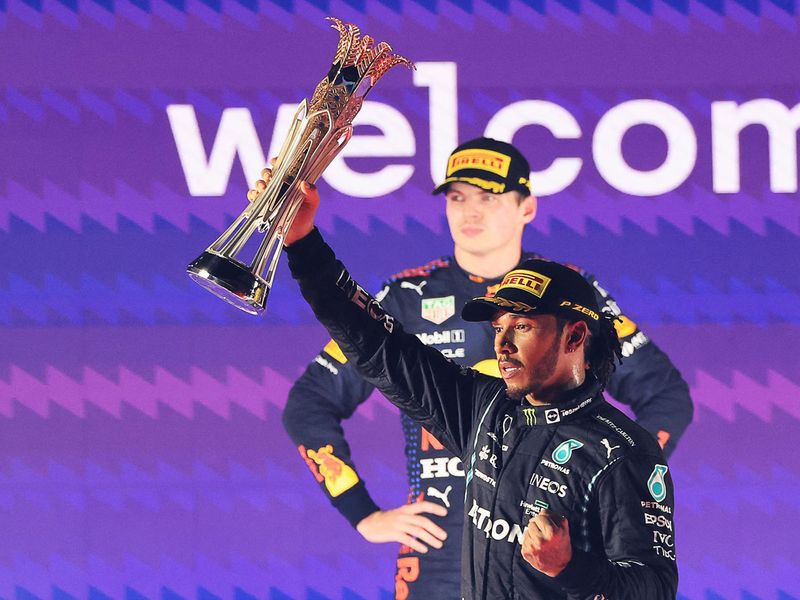
7 titles
Lewis Hamilton has won a joint-record seven World Drivers' Championship titles, and holds the records for the most wins (103), pole positions (103), and podium finishes (181).
The F1 World Championship was born in May 1950 when Silverstone hosted the British Grand Prix — the first sanctioned championship race. There were around 20 races, but only seven were considered for the drivers’ title. Italian teams of Alfa Romeo, Ferrari, and Maserati dominated the early years. Fangio won five World Championship titles (with five different manufacturers), a record which stood for 45 years until German Michael Schumacher won his sixth in 2003. Schumacher and Briton Lewis Hamilton now have a record seven titles.
British F1 engineering dominated from 1958 through the 1960s as Teams Cooper, BRM, Brabham and Lotus won 11 world titles. Between Jim Clark, Jackie Stewart, John Surtees and Graham Hill, British drivers won nine Drivers’ Championships. Lotus became the first team to carry advertising on their cars, and a car with an engine mounted behind the driver won for the first time when Stirling Moss drove Cooper to victory in the 1958 Argentine Grand Prix.
Formula One technology developed rapidly in the 1970s and early 1980s, and raw horsepower was unleashed on the track with the advent of turbo-powered cars (Turbo engines were banned in 1989). The races gave rise to intense sporting rivalries and edge-of-the-seat action. McLaren’s technical superiority remained dominant, but its stars, Ayrton Senna of Brazil and Alain Prost of France, became fierce rivals, often complaining bitterly of each other.
read more
- Formula One Abu Dhabi Grand Prix: All you need to know
- Abu Dhabi Grand Prix marks last race before major changes in F1 from 2022
- UAE’s karting hero Rashid Al Dhaheri ready for another Abu Dhabi Grand Prix
- F1 will race in Abu Dhabi until at least 2030
- Yas Marina Circuit in celebratory mode already as fans return for Abu Dhabi Grand Prix
In the 1990s, innovation and competition to build fast cars drove the technology to complex levels, but F1’s governing bodies moved to make racing safer, especially after the deaths of Senna and Austrian Roland Ratzenberger at the San Marino Grand Prix in Imola, Italy, in 1994. It helped. No driver died on the track in the next 20 years.
Drivers from McLaren, Williams, Renault (formerly Benetton), and Ferrari won the championships from 1984 to 2008. But Schumacher and Ferrari took a stranglehold on the podium, winning five Driver’s titles in a row from 2000 and six Constructor’s titles from 1994. Schumacher retired in 2006 after 16 years of F1 races, setting many records: 91 Grand Prix wins (beaten by Lewis Hamilton last year), most wins in a season (13 out of 18), and most Drivers’ Championships (seven, tied with Hamilton).
After Schumacher’s exit, F1 changed, rules changed, technical regulations were changed, but racing remained fierce. That set the stage for the swift rise of Red Bull Racing, spearheaded by Sebastian Vettel, who in 2010 became the youngest champion in F1 history. The German went on to win four titles.
F1 rules and engines changed again in 2014 with the introduction of 1.6-litre turbocharged hybrid power units. That ushered in a sustained period of dominance by Mercedes AMG and Hamilton. With seven world titles, the Briton staked claim to be the greatest driver of all time.
The global pandemic of COVID-19 stalled racing briefly before F1 returned to the track in 2020. Seven decades on, the Formula One saga continues, bringing together the best drivers and engineers of the world. Lewis Hamilton and Max Verstappen arrive in Abu Dhabi for the final race of 2021 level on points. The race at the Yas Marina Circuit will decide the champion. Stay tuned.
How an F1 race is run
Your guide to Formula One racing
Compiled by Shyam A. Krishna, Senior Associate Editor, and Matt Smith, Sports Editor
If you a newbie, here’s a guide to help make sense of Formula One racing. (Information courtesy: tutorialspoint.com)
Formula One Grand Prix
Formula One Grand Prix is a series of races run on tracks worldwide. ‘Formula’ refers to a standardised set of rules that carmakers and drivers participating in the races have to follow.
Formula One car
A Formula One car is an open-wheel, open-cockpit, single-seat racing car used for racing in competitions. Its engine is located behind the driver, and the car is equipped with two wings: one in the front and another at the rear.
Car design
Formula One cars now are made from carbon fibre and ultra-lightweight components. They are required to weigh a minimum of 746kgs without the driver and fuel in them.
The overall width of the car, excluding tyres, must not exceed 200cm with the wheels in the straight-ahead position. Bodywork width between the front and the rear wheel centre lines must not exceed 160cm. There is no specified maximum length, but all cars tend to be almost the same length.
Car engine
The specifications are four-stroke, turbocharged 1.6-litre, 90 degrees V6 turbo engines. The maximum engine power rotational speed is 15,000 revolutions per minute (rpm).

Steering wheel
The steering wheel of a modern FI car bears little resemblance to the ones in a regular car. It’s more rectangular than round with an array of colourful buttons.
Some of the controls on the steering wheel are engine mapping, brake bias, differential settings, radio, traction control, pit lane speed limiter, rain light, hand clutch, and gearbox neutral button, the gear upshift and downshift levers are located at the back of the steering wheel.
Teams design their steering wheel to suit their drivers, so each team’s steering wheel looks different. But they all feature almost the same components.
Car fuel
The fuel used by Formula One cars is a tightly controlled mixture of ordinary petrol, and can only contain commercial gasoline compounds rather than alcohol compounds.
Car tyres
Formula One cars have been using smooth thread, slick tyres since 2009. The dimensions are:
Front tyres — 245mm (width); Rear tyres — 355mm and 380mm (width)
Speed and performance
All F1 cars can accelerate from 0 to 100 mph (160 kmph) and decelerate back to 0 in under 5 seconds. F1 cars have reached top speeds of about 300 kmph or 185 mph on an average.
Safety gear
Helmets: Helmets are compulsory. Strong and light, they are fire resistant. The average weight of a helmet is around 1.2 kg. Interestingly, the helmets are all painted by hand
HANS: Head and Neck Support is to protect the driver’s vertebrae and collision of head to the steering wheel in the event of an accident. Built using carbon fibre material, it is attached to the seat belt.
Clothing: The multilayered suit is designed to protect drivers from fire during a crash. Nomex is the latest fibre material brand used to build suits for F1 drivers. The suit undergoes thermal testing; it is fire resistant and lightweight. The suit is worn by the pit crew also.
Pits and pit stops
Pit stops for cars are essential to change tyres and make repairs, mechanical adjustments, or as a penalty. Drivers have to make at least one pit stop to change tyres because F1 tyres do not last the race.
Pits are located on the side of racing lanes, and they are assigned in the order of qualifying rankings of the team. A pit may have even up to 20 mechanics who prepare for all eventualities one lap before the car makes a pit stop.
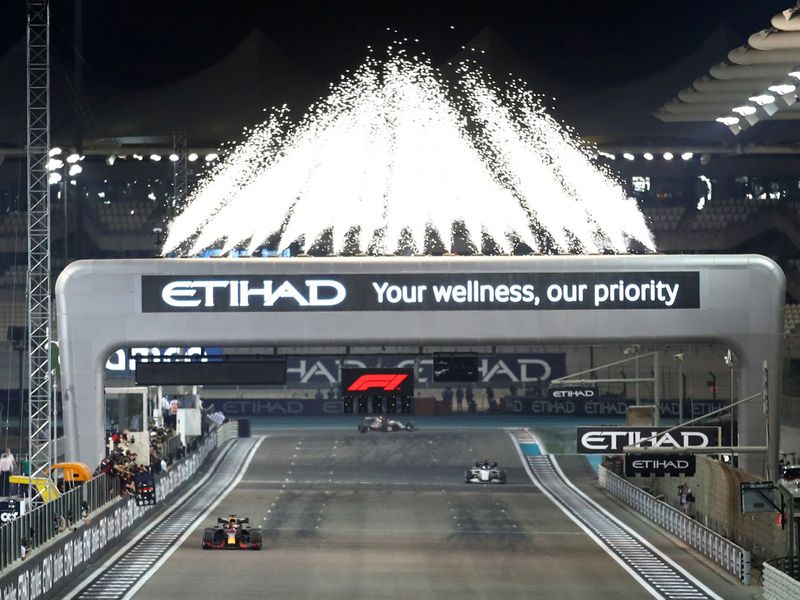
Know the jargons in Formula One racing
These jargons are used commonly by teams and commentators. It will help make sense of the world of Formula One racing.
Backmarker: Trailing drivers are often lapped by the leading drivers. The trailing drivers are referred to as backmarkers just as we refer to backbenchers in schools and colleges.
Blistering/Graining: Blistering is when the cold surface of the track causes pieces to blow out of the tyre surface because the inside of the tyre is warmer. Graining is just the opposite. It is a situation when the tyres are cold, and the hotter surface outside causes the rubber chunks to come off and stick to the tyre.
Box: Box is a reminder to the drivers coming from a controller in the pits that they have a pit stop coming during the lap or in the next lap. The word is derived from the German word ‘Boxenstopp’ which means a pit stop.
Dirty Air/Clean Air: Dirty air is the turbulent air left in the wake of the preceding car. The car coming in the wake of the leading car will experience a drag because of the dirty air. Clean air is the undisturbed air encountered by a car speeding all on its own. The air flows smoothly around the car’s streamlined surface but leaves dirty air in its wake.
5.28 km
The length of Yas Marina Circuit track. It has been shortened slightly to 5.28km from 5.55km and the number of corners reduced from 21 to 16.
DRS: Drag Reduction System (DRS) is allowed to be used in only marked zones on the track. Turbulent air behind the leading car can lead to a drag on the car following it closely, reducing the downforce. A flap on the car is then used to reduce the drag and increase the downforce, which can help the car in overtaking on a straight.
Flatspot: When a car driver locks his front brakes, the front tyres skid along the surface of the track rather than roll across it. This wears the tyres giving it a prominent flat spot. A flatspot on the wheels results in unscheduled pit stops spoiling the chances of the driver in the race.
Marbles: Tiny pieces of rubber that are shredded off the tyres while cornering are called marbles. They accumulate off the racing line, and driving on them can be dangerous as the car loses traction.
Oversteer/Understeer: When a car is cornering, and the rear wheels of the car lose grip and step out of line, the driver is said to have oversteered. On the other hand, if the front wheels lose grip and the car takes a shallower turn than the driver intended, the car has been understeered.
Pole-sitter: A pole-sitter is a driver who wins the pole position in the qualifying races. Pole sitters have an advantage if they get away from the pack and hold the lead into the first corner.
Power Unit: The engine of a modern-day F1 car has ‘power units’ rather than just engines as in the olden days. This unit consists of six components. The Internal Combustion Engine (ICE), the Turbo Charger (TC), the Motor Generator Unit — H (MGU-H), Motor Generator Unit — Kinetic (MGU-K), the Energy Store (ES) and the Control Electronics (CE) taken together is called the Power Unit. These components combine to give an F1 car just below 1,000bhp of power.
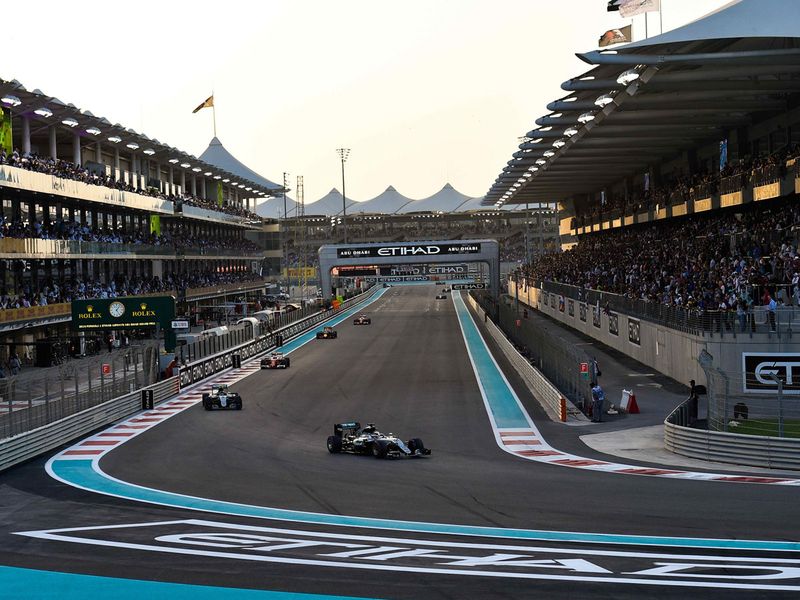
Tech sure made F1 faster, safer
Shyam A. Krishna, Senior Associate Editor
Formula One racing is about fast cars. Technology drives these machines that hurtle around a racetrack at tremendous speeds, steered by highly skilled drivers. F1 became an international sport in the 1950s, and the scramble to develop the fastest car brought together the best engineering minds.
After seven decades, F1 is one of the fastest and safest sports in the world. And it’s been made possible by technology. Innovation and competition brought about improvements. Some changes were banned since they were dangerous, and others robbed the spectators of the drivers’ skill.
In the 1950s, the cars driven by Juan Manuel Fangio to five titles bore little resemblance to the ones that brought seven championships for Lewis Hamilton. The best drivers cannot win with poorly-powered cars. So engineering is as integral as driving skills in Formula One racing.
Here’s a look at some most significant game-changers, with a bit of help from redbull.com.
Mid-engine placement
In the early days of motorsport, the engine was always placed front and centre. At high speeds, this led to understeer (when the front tyres start slipping). Britain’s Cooper made a radical change in 1957 by placing the engine behind the driver but ahead of the rear axle. It provided for even weight distribution. In 1958, Britain’s Stirling Moss drove the Cooper to victory in the Argentine Grand Prix. Jack Brabham’s back-to-back championship wins in 1959 and 1960 convinced other carmakers to follow suit. By 1961, all manufacturers switched to the new standard layout.
Monocoque design
F1 cars were built using a traditional space-frame design (a rigid structure constructed from interlocking components in a geometric pattern). All that changed in 1962, when Lotus introduced the revolutionary aluminium sheet monocoque [single shell or hull], making the car virtually one large body panel. It helped distribute tension and compression across its surface. The design drastically reduced weight, improved acceleration, helped in top speeds and fuel efficiency.
Monocoque is a French term for a single shell (like an eggshell) or single hull. Also called structural skin, it’s a system where loads are supported by the external skin rather than an internal frame.

Active suspension
Active suspension was one of F1’s first electronic driving aids. The system ensured a constant ride height and maximised grip and aerodynamic efficiency. A synthetic spring linked to electronic monitors helped active suspension manage the downforces and make amends for conditions. Data from major circuits was used to programme active suspension to predict the road conditions and adjust the suspension. Since it impacted F1 as a spectacle, the technology was banned in 1994.
Turbochargers
Turbochargers and superchargers [forced induction engines] were banned between 1961-65 but was reintroduced in 1966 after a change in regulations. By 1986, normally aspirated engines had disappeared from the circuit as turbochargers unleashed enormous horsepower. With power, came instability and it was banned again in 1989. The shift to less powerful engines in 2014 allowed turbochargers to return to F1. Present-day cars use a hybrid version.
KERS
Kinetic Energy Recovery System (KERS), introduced in 2009, allows cars to store energy lost during braking and reuse it to provide a short acceleration.
How does it work? Here’s what BBC Top Gear say: Kinetic energy that you would lose to heat while braking is sent to a flywheel, which can capture 150-watt hours in around eight seconds of gentle braking. That’s the same amount of energy you’d need to charge 25 new iPhones. The recovered energy can be stored for about half an hour or used immediately, either as a supplement to the engine or in one great big lump. The former will cut consumption by up to 25 per cent, and the latter will add 80hp instantly.
Traction control
In the event of wheelspin (rotation of wheels without traction), traction control automatically reduces power to the wheels. It allows for near-perfect starts, controlled acceleration, and eliminates drift. Complaints that it reduced the driver’s skill and allegations of exploiting the loopholes led to a ban in 1994 before it was allowed again in 2001. Since 2008, traction control has remained illegal.
Semi-automatic gears
Semi-automatic gears eliminate the need for a driver-controlled clutch. Introduced by Ferrari in 1989, it provides for faster gear changes, allowing the driver to keep the hands on the steering wheel. They also ushered in the era of the modern composite steering wheel with paddles, buttons, toggles, switches and screens, which allow drivers to monitor and control every aspect of the car’s performance.
Halo safety device
The halo safety device has been in the news lately after it saved Romain Grosjean’s life on November 29, following a horrific crash at the 2020 Bahrain Grand Prix that saw his car split in half and engulfed in flames.
Introduced in 2018, halo protects drivers from large pieces of flying debris. It evoked a tepid response from drivers and teams who found it ugly. Some were later convinced about the protection offered by this armour. After the Bahrain crash, there will be more backers for halo.
Since carmakers have to build halo into the chassis, it could impact aerodynamics and stress distribution. Which means more innovation and newer designs.

Comment: Fasten your seatbelts for an F1 classic
Matthew Smith, Sports Editor
Fasten your seatbelts, guys, as we are set for one of the most sensational climaxes in Formula One history.
We have had Prost and Senna, Schumacher, Barrichello, Hakkinen, Massa and Alonso, Button, Hill and Mansell. But this year’s finale to the F1 season in Abu Dhabi could top the list of rivalries as young pretender Max Verstappen and seven-time champion Lewis Hamilton cannot be separated after a frenetic, fast-paced and feisty season-long feud.
It seemed like we were witnessing a passing of the crown as the young Dutchman seemed to have the edge over his senior after years of coming up short, while the Briton was making history and shattering records.
Verstappen was the odds-on favourite to claim his first Drivers’ title as he surged ahead in the points standings earlier this year in his Red Bull, while Hamilton and Mercedes searched for answers.
60,000
The four-day Abu Dhabi Grand Prix race festival will welcome 60,000 motorsports fans with 55 per cent coming from abroad.
But then something happened ... Hamilton rediscovered his mojo — channelling a younger version of himself to give as good as he got from the latest of his rivals wanting to topple him from his throne. One thing is for sure this season, Hamilton does not go down without a fight and, after controversial races in Brazil and Jeddah — plus a classic cruise in Qatar after a total of 25 grid position penalties for Hamilton over the weekend — the pair are now level on points.
While Verstappen has the slight advantage in race-win countback, the momentum is clearly with Hamilton as a series of ‘rookie’ errors have hindered the Dutchman — the youngest ever driver in an F1 race some seven years ago as a 17-year-old (he was in an F1 cockpit at 300kph before he even had a driver’s licence).
In recent years, such has been Hamilton’s dominance, the title had been settled long before the entourage descended on the UAE, but not a chance of that this time around, with Verstappen and Hamilton fighting tooth and nail for the bragging rights — sometimes with unfortunate consequences due to some erratic driving from both drivers as the season got more heated.
There has been no shortage of finger-pointing across the pit-lane as Red Bull and Mercedes blamed each other for a series of comings-together between the two best drivers on the planet.
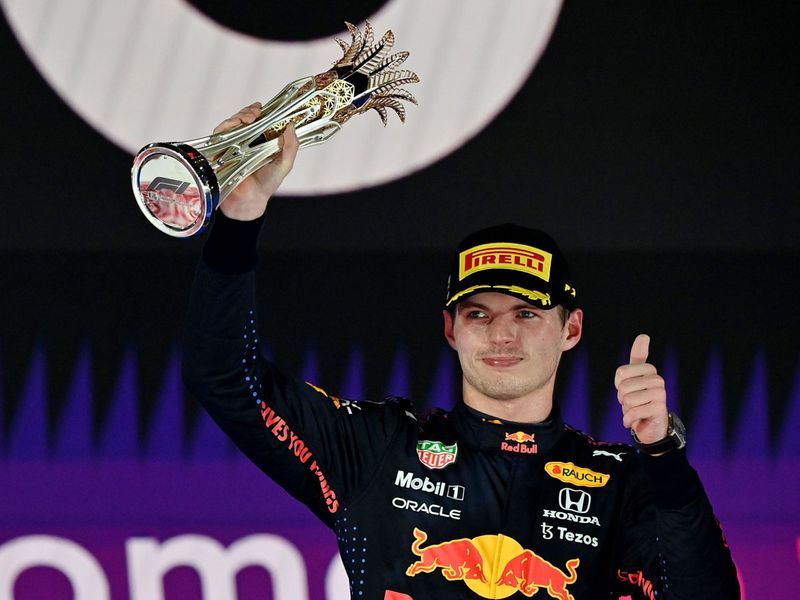
It really got interesting in Brazil when Verstappen, under pressure from a vastly improved Hamilton Mercedes, appearing to force his rival off the track rather than ceding position. He avoided a penalty on that occasion and Hamilton eventually got past to win. This past weekend in Saudi Arabia — hosting its first ever Grand Prix — was almost an action replay as both drivers ran wide as Hamilton looked to overtake. Verstappen was not as fortunate this time around and was ordered to cede the position to Hamilton as he was ruled to gain an advantage by cutting a corner.
It would take a braver man than me to make a call on how things will go in Abu Dhabi, but fireworks will be guaranteed. Verstappen’s passion versus Hamilton’s cool head, it could all come down to one corner or one incident yet again, and it could go a long way to setting the stage for the future of the sport. Can Hamilton claim another record with an eighth title, or are we witnessing a changing of the guard? We will know soon enough.
Another intriguing factor is the Abu Dhabi track at Yas Marina Circuit, where major developments mean more overtaking opportunities and wheel-to-wheel racing.
For the first time in 13 years, drivers and teams will be facing unknown elements at Yas, with the new track layout — shortened by 273 metres to 5.28km.
Practice will be just as crucial as the race itself as teams look to find an advantage on the new track and qualifying could come down to fraction of a second and give either Hamilton or Verstappen the edge and pole position on Sunday. The rest is up to them...




